window SATURN L-SERIES 2005 Owners Manual
[x] Cancel search | Manufacturer: SATURN, Model Year: 2005, Model line: L-SERIES, Model: SATURN L-SERIES 2005Pages: 330, PDF Size: 2.4 MB
Page 1 of 330
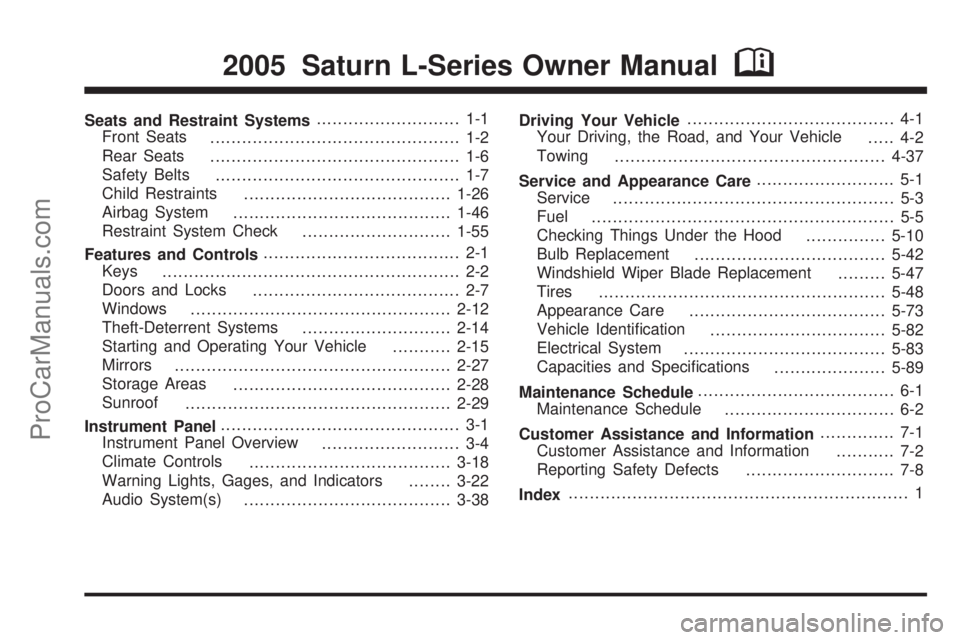
Seats and Restraint Systems........................... 1-1
Front Seats
............................................... 1-2
Rear Seats
............................................... 1-6
Safety Belts
.............................................. 1-7
Child Restraints
.......................................1-26
Airbag System
.........................................1-46
Restraint System Check
............................1-55
Features and Controls..................................... 2-1
Keys
........................................................ 2-2
Doors and Locks
....................................... 2-7
Windows
.................................................2-12
Theft-Deterrent Systems
............................2-14
Starting and Operating Your Vehicle
...........2-15
Mirrors
....................................................2-27
Storage Areas
.........................................2-28
Sunroof
..................................................2-29
Instrument Panel............................................. 3-1
Instrument Panel Overview
.......................... 3-4
Climate Controls
......................................3-18
Warning Lights, Gages, and Indicators
........3-22
Audio System(s)
.......................................3-38Driving Your Vehicle....................................... 4-1
Your Driving, the Road, and Your Vehicle
..... 4-2
Towing
...................................................4-37
Service and Appearance Care.......................... 5-1
Service
..................................................... 5-3
Fuel
......................................................... 5-5
Checking Things Under the Hood
...............5-10
Bulb Replacement
....................................5-42
Windshield Wiper Blade Replacement
.........5-47
Tires
......................................................5-48
Appearance Care
.....................................5-73
Vehicle Identification
.................................5-82
Electrical System
......................................5-83
Capacities and Specifications
.....................5-89
Maintenance Schedule..................................... 6-1
Maintenance Schedule
................................ 6-2
Customer Assistance and Information.............. 7-1
Customer Assistance and Information
........... 7-2
Reporting Safety Defects
............................ 7-8
Index................................................................ 1
2005 Saturn L-Series Owner ManualM
ProCarManuals.com
Page 32 of 330

Safety Belt Extender
If the vehicle’s safety belt will fasten around you,
you should use it.
But if a safety belt is not long enough, your retailer will
order you an extender. It is free. When you go in to
order it, take the heaviest coat you will wear, so
the extender will be long enough for you. To help avoid
personal injury, do not let someone else use it, and
use it only for the seat it is made to fit. The extender has
been designed for adults. Never use it for securing
child seats. To wear it, just attach it to the regular safety
belt. For more information see the instruction sheet
that comes with the extender.
Child Restraints
Older Children
Older children who have outgrown booster seats should
wear the vehicle’s safety belts. If you have the choice,
a child should sit next to a window so the child can wear
a lap-shoulder belt and get the additional restraint a
shoulder belt can provide.
1-26
ProCarManuals.com
Page 34 of 330

Q:What if a child is wearing a lap-shoulder belt,
but the child is so small that the shoulder belt
is very close to the child’s face or neck?
A:If the child is sitting in a seat next to a window,
move the child toward the center of the vehicle.
Also seeRear Safety Belt Comfort Guides for
Children and Small Adults on page 1-24. If the child
is sitting in the center rear seat passenger
position, move the child toward the safety belt
buckle. In either case, be sure that the shoulder belt
still is on the child’s shoulder, so that in a crash
the child’s upper body would have the restraint that
belts provide.
1-28
ProCarManuals.com
Page 41 of 330

A booster seat (F-G) is a child restraint designed to
improve the fit of the vehicle’s safety belt system. Some
booster seats have a shoulder belt positioner, and
some high-back booster seats have a five-point harness.
A booster seat can also help a child to see out the
window.
Q:How do child restraints work?
A:A child restraint system is any device designed for
use in a motor vehicle to restrain, seat, or position
children. A built-in child restraint system is a
permanent part of the motor vehicle. An add-on
child restraint system is a portable one, which
is purchased by the vehicle’s owner.
For many years, add-on child restraints have used
the adult belt system in the vehicle. To help
reduce the chance of injury, the child also has to be
secured within the restraint. The vehicle’s belt
system secures the add-on child restraint in the
vehicle, and the add-on child restraint’s harness
system holds the child in place within the restraint.
One system, the three-point harness, has straps that
come down over each of the infant’s shoulders and
buckle together at the crotch. The five-point harness
system has two shoulder straps, two hip straps and a
crotch strap. A shield may take the place of hip
straps. A T-shaped shield has shoulder straps that
are attached to a flat pad which rests low against the
child’s body. A shelf- or armrest-type shield has
straps that are attached to a wide, shelf-like shield
that swings up or to the side.
1-35
ProCarManuals.com
Page 55 of 330
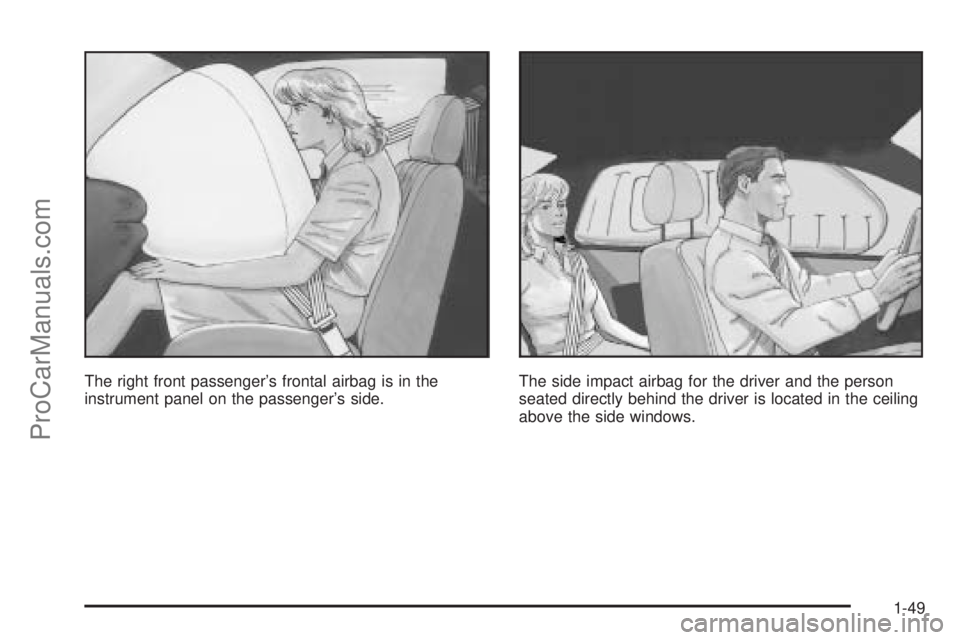
The right front passenger’s frontal airbag is in the
instrument panel on the passenger’s side.The side impact airbag for the driver and the person
seated directly behind the driver is located in the ceiling
above the side windows.
1-49
ProCarManuals.com
Page 56 of 330

The side impact airbag for the right front passenger and
the person seated directly behind that passenger is
located in the ceiling above the side windows.
{CAUTION:
If something is between an occupant and an
airbag, the bag might not in�ate properly or it
might force the object into that person causing
severe injury or even death. The path of an
in�ating airbag must be kept clear. Do not put
anything between an occupant and an airbag,
and do not attach or put anything on the
steering wheel hub or on or near any other
airbag covering. And, because your vehicle
has side impact airbags, never secure anything
to the roof of your vehicle by routing the rope
or tiedown through any door or window
opening. If you do, the path of an in�ating side
impact airbag will be blocked. The path of an
in�ating airbag must be kept clear.
1-50
ProCarManuals.com
Page 58 of 330
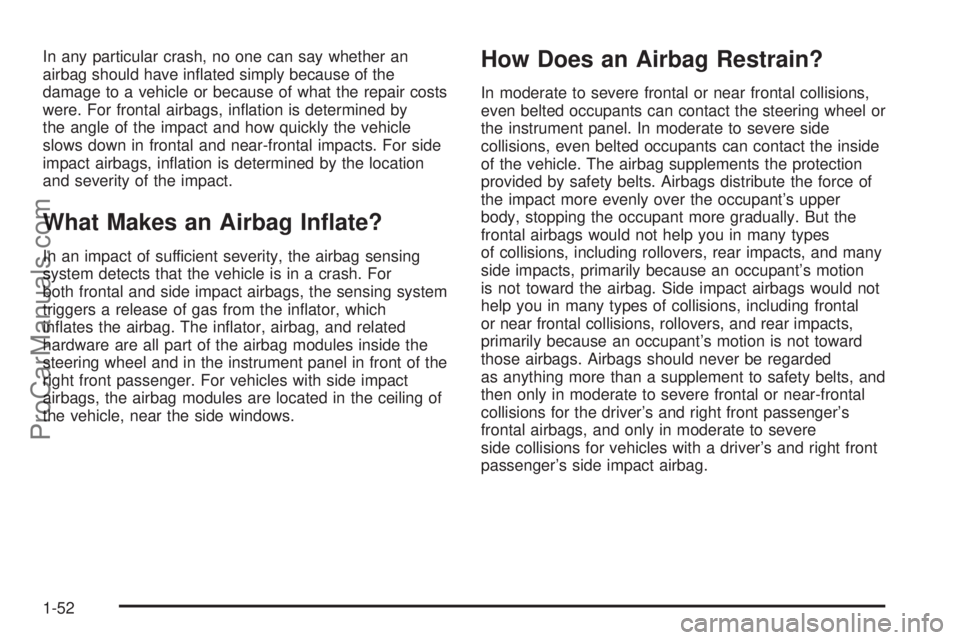
In any particular crash, no one can say whether an
airbag should have inflated simply because of the
damage to a vehicle or because of what the repair costs
were. For frontal airbags, inflation is determined by
the angle of the impact and how quickly the vehicle
slows down in frontal and near-frontal impacts. For side
impact airbags, inflation is determined by the location
and severity of the impact.
What Makes an Airbag In�ate?
In an impact of sufficient severity, the airbag sensing
system detects that the vehicle is in a crash. For
both frontal and side impact airbags, the sensing system
triggers a release of gas from the inflator, which
inflates the airbag. The inflator, airbag, and related
hardware are all part of the airbag modules inside the
steering wheel and in the instrument panel in front of the
right front passenger. For vehicles with side impact
airbags, the airbag modules are located in the ceiling of
the vehicle, near the side windows.
How Does an Airbag Restrain?
In moderate to severe frontal or near frontal collisions,
even belted occupants can contact the steering wheel or
the instrument panel. In moderate to severe side
collisions, even belted occupants can contact the inside
of the vehicle. The airbag supplements the protection
provided by safety belts. Airbags distribute the force of
the impact more evenly over the occupant’s upper
body, stopping the occupant more gradually. But the
frontal airbags would not help you in many types
of collisions, including rollovers, rear impacts, and many
side impacts, primarily because an occupant’s motion
is not toward the airbag. Side impact airbags would not
help you in many types of collisions, including frontal
or near frontal collisions, rollovers, and rear impacts,
primarily because an occupant’s motion is not toward
those airbags. Airbags should never be regarded
as anything more than a supplement to safety belts, and
then only in moderate to severe frontal or near-frontal
collisions for the driver’s and right front passenger’s
frontal airbags, and only in moderate to severe
side collisions for vehicles with a driver’s and right front
passenger’s side impact airbag.
1-52
ProCarManuals.com
Page 59 of 330
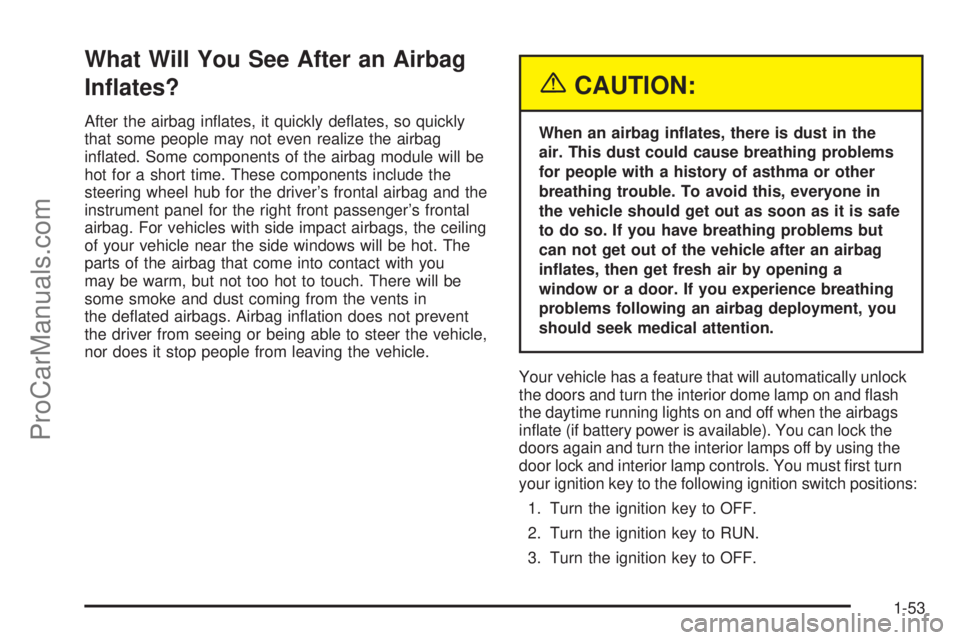
What Will You See After an Airbag
In�ates?
After the airbag inflates, it quickly deflates, so quickly
that some people may not even realize the airbag
inflated. Some components of the airbag module will be
hot for a short time. These components include the
steering wheel hub for the driver’s frontal airbag and the
instrument panel for the right front passenger’s frontal
airbag. For vehicles with side impact airbags, the ceiling
of your vehicle near the side windows will be hot. The
parts of the airbag that come into contact with you
may be warm, but not too hot to touch. There will be
some smoke and dust coming from the vents in
the deflated airbags. Airbag inflation does not prevent
the driver from seeing or being able to steer the vehicle,
nor does it stop people from leaving the vehicle.
{CAUTION:
When an airbag in�ates, there is dust in the
air. This dust could cause breathing problems
for people with a history of asthma or other
breathing trouble. To avoid this, everyone in
the vehicle should get out as soon as it is safe
to do so. If you have breathing problems but
can not get out of the vehicle after an airbag
in�ates, then get fresh air by opening a
window or a door. If you experience breathing
problems following an airbag deployment, you
should seek medical attention.
Your vehicle has a feature that will automatically unlock
the doors and turn the interior dome lamp on and flash
the daytime running lights on and off when the airbags
inflate (if battery power is available). You can lock the
doors again and turn the interior lamps off by using the
door lock and interior lamp controls. You must first turn
your ignition key to the following ignition switch positions:
1. Turn the ignition key to OFF.
2. Turn the ignition key to RUN.
3. Turn the ignition key to OFF.
1-53
ProCarManuals.com
Page 60 of 330
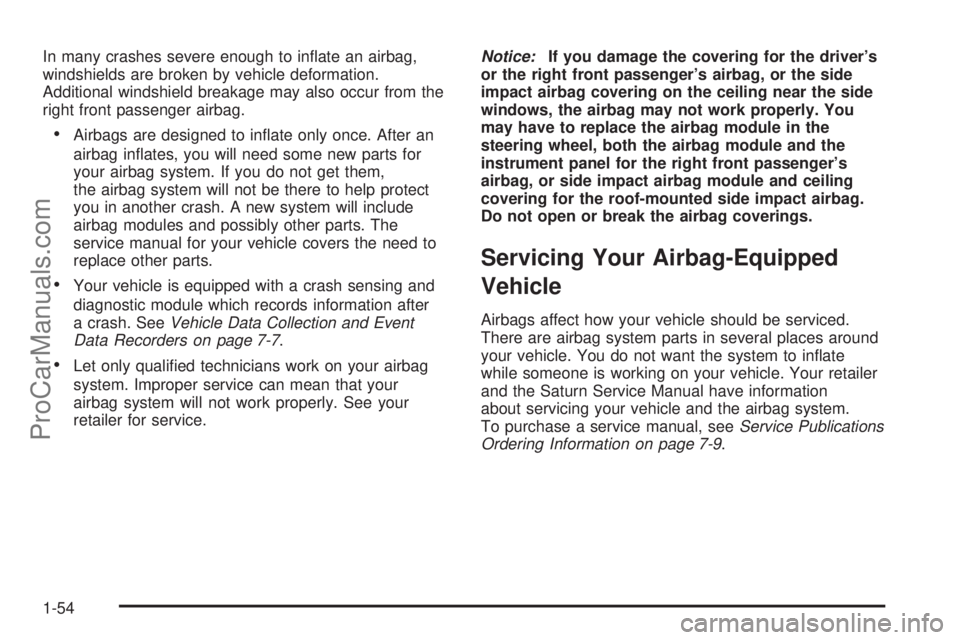
In many crashes severe enough to inflate an airbag,
windshields are broken by vehicle deformation.
Additional windshield breakage may also occur from the
right front passenger airbag.
•Airbags are designed to inflate only once. After an
airbag inflates, you will need some new parts for
your airbag system. If you do not get them,
the airbag system will not be there to help protect
you in another crash. A new system will include
airbag modules and possibly other parts. The
service manual for your vehicle covers the need to
replace other parts.
•Your vehicle is equipped with a crash sensing and
diagnostic module which records information after
a crash. SeeVehicle Data Collection and Event
Data Recorders on page 7-7.
•Let only qualified technicians work on your airbag
system. Improper service can mean that your
airbag system will not work properly. See your
retailer for service.Notice:If you damage the covering for the driver’s
or the right front passenger’s airbag, or the side
impact airbag covering on the ceiling near the side
windows, the airbag may not work properly. You
may have to replace the airbag module in the
steering wheel, both the airbag module and the
instrument panel for the right front passenger’s
airbag, or side impact airbag module and ceiling
covering for the roof-mounted side impact airbag.
Do not open or break the airbag coverings.
Servicing Your Airbag-Equipped
Vehicle
Airbags affect how your vehicle should be serviced.
There are airbag system parts in several places around
your vehicle. You do not want the system to inflate
while someone is working on your vehicle. Your retailer
and the Saturn Service Manual have information
about servicing your vehicle and the airbag system.
To purchase a service manual, seeService Publications
Ordering Information on page 7-9.
1-54
ProCarManuals.com
Page 63 of 330
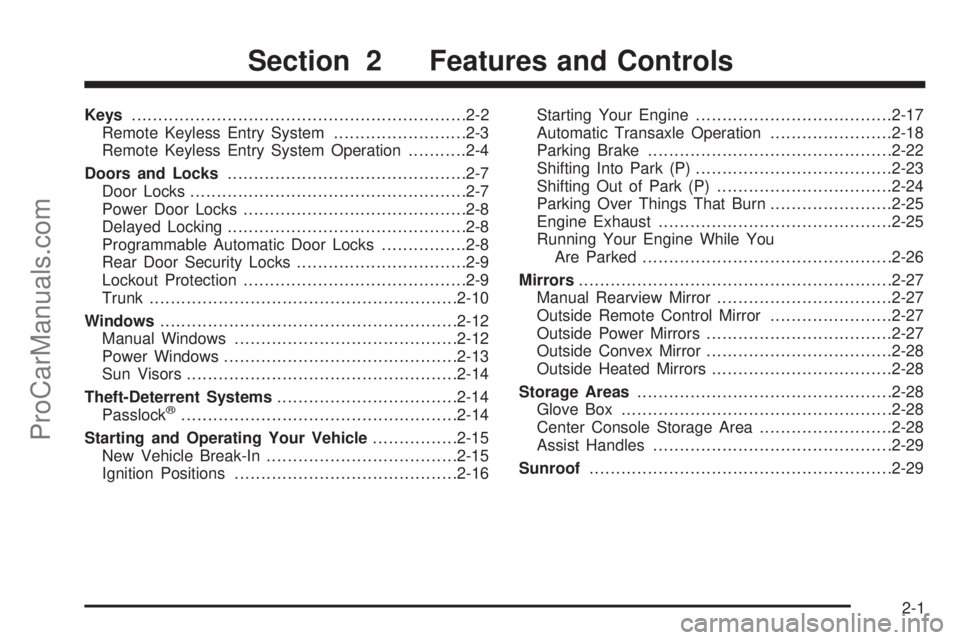
Keys...............................................................2-2
Remote Keyless Entry System.........................2-3
Remote Keyless Entry System Operation...........2-4
Doors and Locks.............................................2-7
Door Locks....................................................2-7
Power Door Locks..........................................2-8
Delayed Locking.............................................2-8
Programmable Automatic Door Locks................2-8
Rear Door Security Locks................................2-9
Lockout Protection..........................................2-9
Trunk..........................................................2-10
Windows........................................................2-12
Manual Windows..........................................2-12
Power Windows............................................2-13
Sun Visors...................................................2-14
Theft-Deterrent Systems..................................2-14
Passlock
®....................................................2-14
Starting and Operating Your Vehicle................2-15
New Vehicle Break-In....................................2-15
Ignition Positions..........................................2-16Starting Your Engine.....................................2-17
Automatic Transaxle Operation.......................2-18
Parking Brake..............................................2-22
Shifting Into Park (P).....................................2-23
Shifting Out of Park (P).................................2-24
Parking Over Things That Burn.......................2-25
Engine Exhaust............................................2-25
Running Your Engine While You
Are Parked...............................................2-26
Mirrors...........................................................2-27
Manual Rearview Mirror.................................2-27
Outside Remote Control Mirror.......................2-27
Outside Power Mirrors...................................2-27
Outside Convex Mirror...................................2-28
Outside Heated Mirrors..................................2-28
Storage Areas................................................2-28
Glove Box...................................................2-28
Center Console Storage Area.........................2-28
Assist Handles.............................................2-29
Sunroof.........................................................2-29
Section 2 Features and Controls
2-1
ProCarManuals.com